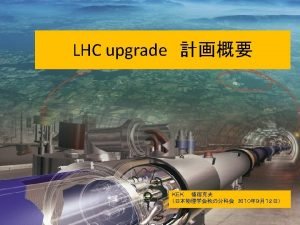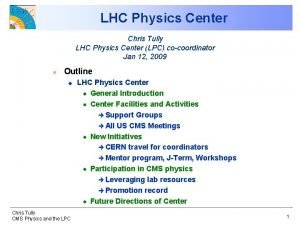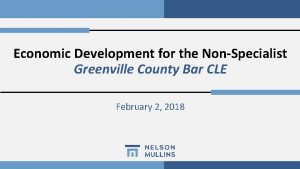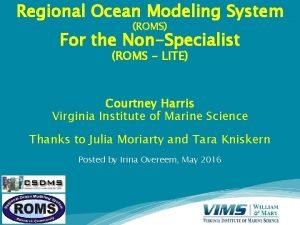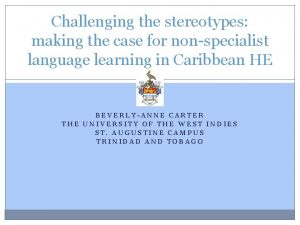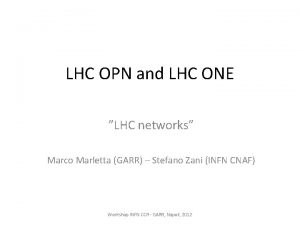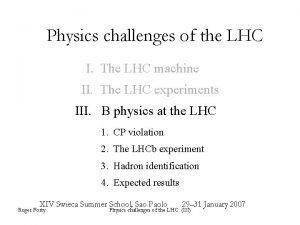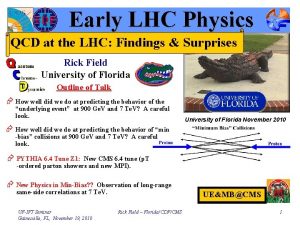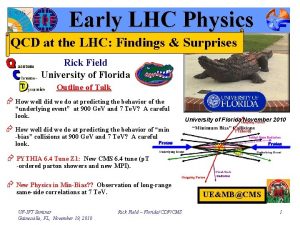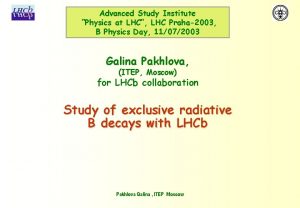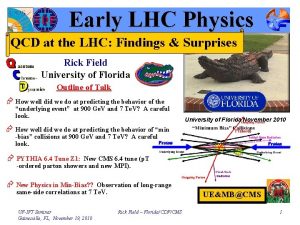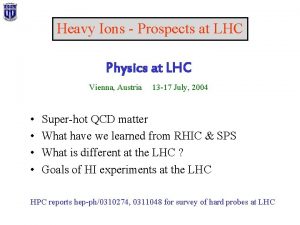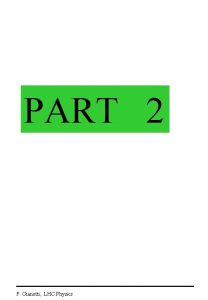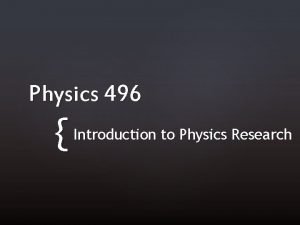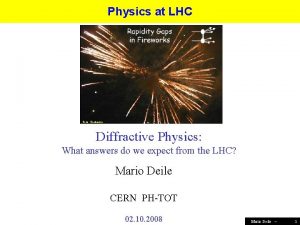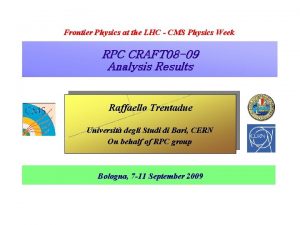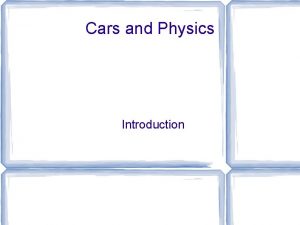LHC Physics A nonspecialist introduction to the LHC











































- Slides: 43

LHC Physics A non-specialist introduction to the LHC, the Standard Model, and some of the physics goals of the LHC David Evans The University of Birmingham, UK Triggering Discoveries in HEP II, Puebla, Mexico 29 th January – 1 st February 2018 1

Outline of Talk • The Large Hadron Collider – and LHC collision kinematics • • Non-specialist outline of the standard model Physics beyond the standard model Some of the physics goals of the LHC ATLAS and CMS main physics aims LHCb main physics aims ALICE main physics aims Summary and Conclusions 2

In Switzerland… Situated on the Swiss-French border, near Geneva Is the World’s largest physics laboratory 3

CERN & the LHC ~100 metres underground, is the World’s most powerful particle accelerator French Alps Geneva The Large Hadron Collider (LHC) Which accelerates sub-atomic particles to 0. 99991 the speed of light (protons to 6. 5 Te. V and lead ions to 2. 5 Te. V/nucleon) 4

Large Hadron Collider …. and collides them together in four cathedral-sized caverns around the 27 km ring. Creating sub-atomic explosions, and conditions that existed less than a billionth of a second after the Big Bang. In 4 massive particle detectors (& 2 smaller ones) Up to 600 million times per second 5

LHC Collision Kinematics = 0 ( = 90 o) particle = 0. 88 ( = 45 o) Incoming beam (as 0) Incoming beam Side view of detector 6

LHC Tunnel 7

LHC - Facts • 27 km circumference • Each proton (or lead nucleon) goes around the 27 km ring over 11, 000 times a second. • 300 trillion protons in the beam • Energy of proton beam in LHC > 0. 3 GJ (freight train travelling at 100 mph) • Super-conducting magnets cooled to ~ 1. 9 K (colder than Outer Space). • Vacuum as low as interplanetary space (10 -13 atm) 8

The LHC 9

High-Energy Physics what’s it all about? • By recreating the conditions of the Big Bang (well, a billionth of a second afterwards) • We are able to study the basic building blocks of matter – i. e. Fundamental particles • Their properties • and the forces which act between them. So we want to know what everything in the Universe is made of and how it works. 10

Building Blocks of Matter We know § All matter around us is made of atoms. § Atoms consist of a positive nucleus (containing 99. 98% of the atom’s mass) and a cloud of electrons. § Nuclei consist of protons and neutrons. § The protons and neutrons are made of three quarks. in metres < 10 -21 100, 000, 000 11

Elementary Particles q Protons and neutrons are made from two types of quarks: Up (u) and Down (d). q u-quarks have electric charge +2/3 while d-quarks have charge – 1/3 (electron has electric charge -1 in these units). Neutron Proton +2/3 -1/3 U d +2/3 U +2/3 -1/3 U d -1/3 d 12

Elementary Particles Actually, a proton or neutron, with any energy will probably look more like this. Full of sea-quarks and anti-quarks 13

Family of Particles So, there is a family of particles: Up quark (u) Down quark (d) Electron (e-) Mass ~ 0. 003 ~ 0. 006 = 0. 0005 (relative to the mass of a single proton) Electron neutrino ( e) < 10 -8 ? Everything around us (the whole Periodic Table) is made up of the first three particles. 14

BUT…. quarks Nature supplies us with two extra families that are very much heavier: charm up down top strange bottom leptons All particles have a quantum number call spin and all these matter particles have spin ½ i. e. they are fermions e e 15

No Free Quarks Observed Free quarks are not observed experimentally Quarks carry an extra quantum number called colour: 3 colour charges (red, green, blue) anti-quarks carry anti-colour charge ( red , green, blue) Free particles must have no net colour i. e. made of 3 quarks: Baryon (e. g. proton) Or quark & anti-quark: Meson (e. g. pion) b g r b b 16

Virtual Particles The forces between fundamental particles are mediated by virtual carrier particles. For example, the electromagnetic interaction between two charged particles (say two electrons) is understood to be due to the exchange of virtual photons. A virtual particle is one that violates conservation of energy, but only for a short period of time ( t < ħ/ E) – it ‘borrows’ energy using the Heisenberg uncertainty principle. 17 17

The Forces Gravity – stars, planets etc. Force Range Gravitational long Weak short Electromagnetic long Strong short Proton Neutron Weak – beta decay, also how stars generate energy Electromagnetic – atoms, electricity etc. Mediator Rel. Strength graviton (massless) ? ? 10 -35 W, Z bosons (heavy) 0. 01 photon (massless) 1 gluons (massless) 1000 Strong – binds quarks (residual force binds nucleons in nuclei) 18

The Standard Model u c t d s b e } } quarks leptons 12 matter particles – all fermions (spin ½ ) 19

The Weak Force u W+ c t d s b e } } quarks leptons WZ 0 20

The Electromagnetic Force u c t d s b e } } quarks leptons Photon 21

The Strong Force u g gluon c t d s b e } } quarks leptons 8 different types of gluons Gravity too weak to even consider at the sub-atomic scale 22

Antimatter v Every fundamental particle has its antiparticle. § These have the same mass but opposite charge. electron e- e+ up quark u+2/3 u-2/3 positron up anti-quark Etc. 23

What is Mass? The big problem with the early standard model was that theory only explained interactions via massless force-carrying particles, but we know the W and Z have mass. In the mid 1960 s, British physicist Peter Higgs and others came up with a way to generate mass without destroying the SM. He proposed a new type of field which particles interact with to gain mass. According to the SM Just one problem with the a new field implies a new theory … Nobody had seen the particle – the Higgs boson. Higgs particle! This was the main reason to build the LHC, if the SM was right, the Higgs would be discovered at LHC energies 24

Basis of Standard Model 25

Mathematical Tools of the Standard Model Ø 12 matter particles (& 12 anti-particles) § 3 generations (all fermions i. e. ½ integer spin) Ø 4 types of force carriers (all bosons i. e. integer spin) Ø Plus Higgs Boson (spin 1) Ø The mathematics is called a Quantum Field Theory (QFT) Ø combines classical fields, special relativity and quantum mechanics. Ø In QFT, the particles are excited states of the field. Ø The QFT contains the internal symmetries which form the product group SU(3) SU(2) U(1) (QCD weak QED) 26

Unification of the Forces The four fundamental forces appear to be very different but they behave differently at different energy scales. The electromagnetic and weak nuclear force are said to be unified at a high enough energy level (~100 Ge. V) – the electroweak interaction. The natural question following that is if, at even higher energies, the other forces unify in a similar way? 27

Problems with the SM The SM is one of the most successful models in physics. However, it does have some short comings. Perhaps it is a lowenergy approximation to a more complete theory (in the way Newton’s laws are a low speed approximation to special relativity). Some of the phenomena not explained by the SM are: • Gravity – not explained, why so weak? , SM incompatible with general relativity • Dark Matter & Dark Energy – accounts for 95% mass of universe but not included in SM • Neutrino masses – not massless but very small • Matter/anti-matter asymmetry – SM does not explain the amount of matter/anti-matter asymmetry at Big Bang • Number of parameters – SM has about 19 free parameters: not exactly ideal. 28

Many More Questions … Ar di e th m en ere si on ext s? ra Wh y hav do pa e r hav the m ticles e? ass the y cle i t r a p er t s t r a Are there just 4 forces? e i m r r e a r Why a and force c ns o i m r e f & 12 matter particles? s? n o s o b s How to hadrons get k r ua made q d l or their mass (Higgs only n a s a l t n n o e t accounts for ~2%)? a p t Wh m e n l a e yn re fund dam ? A s e o fr y n l v l l ee q rea ore fu emse uar h m t f s o ks? le c i t par 29

These problems / questions are being addressed by the LHC 4 main experiments, two smaller ones CMS ALICE: creating highest densities and temperatures in Pb-Pb collisions. Study of primordial state of matter QGP ATLAS & CMS looking for Higgs, new particles, physics beyond the standard model LHCb: highest precision measurements of matter/antimatter differences LHCb ALICE ATLAS 30

Beyond the Standard Model (BSM) There are lots of symmetries in the SM so it would be rather nice to add another symmetry where every ½ integer spin (fermion) matter particle has an integer spin (boson) partner and every integer spin force particle has a ½ integer spin partner. This theory is known as supersymmetry or SUSY where each particle has a SUSY partner with a spin that differs by ½ unit. 31

Advantages of SUSY In the SM the strength of the forces converge with energy but not at the same place. SUSY allows the forces to converge at the same energy meaning a single (gauge) theory can represent the forces. A spin-off of SUSY is the lowest mass particle is an excellent candidate for Dark Matter. Lot’s of other BSM theories out there. 32

ATLAS & CMS Main aims: Ø Discover and study the Higgs Boson Ø Direct searches for new heavy particles beyond SM (e. g. SUSY) Ø The origin of dark matter Ø Other new physics e. g. extra dimensions etc. Focus on high p. T particles, excellent calorimetry, muon detection, high interaction rates 33

Matter/Anti-matter problem Matter/anti-matter symmetry suggests equal amounts of matter and anti-matter should have been created during the Big Bang. • But we live in a universe made from matter. • Where did all the anti-matter go? • main aim of LHCb is to solve this problem. 34

CP Symmetry CP symmetry (where C is charge and P is parity) basically states that a particle and its anti-particle should behave exactly the same (same lifetime, symmetric decays etc. ). CP-symmetry seems to be conserved in the strong and electromagnetic interactions but is slightly violated in certain weak decays. CP Violation is ‘add-on’ in SM CP requires a complex phase in 3 generation CKM matrix, allowed but not natural 35

Matter/Anti-matter problem To explain matter dominance in the Universe we require: Ø CP-violation Ø Baryon number violation Ø Thermal non-equilibrium The latter two can be created in a 1 st order phase transition in the very early Universe Ø Problem: SM-Higgs is too heavy to generate 1 st order phase transition and the CP-violation in the SM (via quark mixing matrices etc) is too small to explain amount of matter In the Universe. Ø Need to look for extra sources of CP-violation i. e. new physics in CP violation. 36

BSM Indirect Searches Precision measurement can show up PBSM e. g. existence of extra particles would show up in small changes in particle lifetimes and decay fractions. eg, in SUSY the B mesons can mix via gluino box Analysis of the differential decay rate of Bs J/ψΚΚ in Ω, t, flavour tagging, m. KK. 37

LHCb Main physics aims: v. Find new sources of CP violation v. Indirect search for physics beyond the standard model v. Precision measures of bdecays v. Search for exotic states of matter Detector requirements: Ø Very high precision decay vertex finding Ø Tracking detectors very close to beam collision point Ø Excellent tracking Ø PID 38

The Quark-Gluon Plasma Normal hadronic matter Soup of free quarks – Quark-Gluon Plasma At extreme temperatures and/or densities hadronic matter ‘melts’ into a plasma of free quarks and gluons. This state of matter would have existed up to about 10 millionths of a second after the Big Bang, and could be created in the core of collapsing neutron stars. 39

Heavy Ion Collisions Create QGP by colliding ultra-relativistic heavy ions Jets Open charm, beauty v Particles produced in violent collisions are the probes to study QGP. v Different observables give different information about the 40 system

The ALICE Experiment Size: 16 x 26 metres Weight: 10, 000 tonnes Detectors: 18 Main physics aims: v Create and study the Quark-Gluon Plasma (by colliding lead ions) v Study of QCD under extreme conditions v p-p and p-Pb collisions used as experiment control Detector requirements: § although these now Ø Ability to reconstruct ~ 15, 000 particles seem very / collision interesting in their Ø Excellent tracking down to low p. T own right. Ø Excellent particle identification 41

Exploring New Frontiers • The LHC Project is pushing out the frontiers of physics in three directions: Highest temperatures and densities Recreate primordial soup (quark-gluon plasma) – a millionth of a second after Big Bang ALICE Highest Precision - Differences between matter and anti -matter LHCb Highest energy collisions - new particles, eg Higgs, dark matter particles, etc. All looking for New physics ATLAS and CMS 42

Summary • The standard model of high-energy physics is one of our most successful models. – However it does have its problems and can’t explain everything observed. • The Large Hadron Collider and its experiments aim to address some of these issues and discover new physics. • The LHC has already shown us some new and exciting physics (wasn’t allowed to talk about physics!). • The future is going to be even more exciting. Thank you for listening. 43
 Hadrons
Hadrons Modern physics vs classical physics
Modern physics vs classical physics University physics with modern physics fifteenth edition
University physics with modern physics fifteenth edition Ib physics ia ideas
Ib physics ia ideas Hình ảnh bộ gõ cơ thể búng tay
Hình ảnh bộ gõ cơ thể búng tay Frameset trong html5
Frameset trong html5 Bổ thể
Bổ thể Tỉ lệ cơ thể trẻ em
Tỉ lệ cơ thể trẻ em Gấu đi như thế nào
Gấu đi như thế nào Tư thế worm breton là gì
Tư thế worm breton là gì Hát lên người ơi
Hát lên người ơi Các môn thể thao bắt đầu bằng tiếng bóng
Các môn thể thao bắt đầu bằng tiếng bóng Thế nào là hệ số cao nhất
Thế nào là hệ số cao nhất Các châu lục và đại dương trên thế giới
Các châu lục và đại dương trên thế giới Công của trọng lực
Công của trọng lực Trời xanh đây là của chúng ta thể thơ
Trời xanh đây là của chúng ta thể thơ Mật thư anh em như thể tay chân
Mật thư anh em như thể tay chân Phép trừ bù
Phép trừ bù Phản ứng thế ankan
Phản ứng thế ankan Các châu lục và đại dương trên thế giới
Các châu lục và đại dương trên thế giới Thể thơ truyền thống
Thể thơ truyền thống Quá trình desamine hóa có thể tạo ra
Quá trình desamine hóa có thể tạo ra Một số thể thơ truyền thống
Một số thể thơ truyền thống Cái miệng bé xinh thế chỉ nói điều hay thôi
Cái miệng bé xinh thế chỉ nói điều hay thôi Vẽ hình chiếu vuông góc của vật thể sau
Vẽ hình chiếu vuông góc của vật thể sau Biện pháp chống mỏi cơ
Biện pháp chống mỏi cơ đặc điểm cơ thể của người tối cổ
đặc điểm cơ thể của người tối cổ Thế nào là giọng cùng tên? *
Thế nào là giọng cùng tên? * Vẽ hình chiếu đứng bằng cạnh của vật thể
Vẽ hình chiếu đứng bằng cạnh của vật thể Tia chieu sa te
Tia chieu sa te Thẻ vin
Thẻ vin đại từ thay thế
đại từ thay thế điện thế nghỉ
điện thế nghỉ Tư thế ngồi viết
Tư thế ngồi viết Diễn thế sinh thái là
Diễn thế sinh thái là Dot
Dot Số nguyên tố là số gì
Số nguyên tố là số gì Tư thế ngồi viết
Tư thế ngồi viết Lời thề hippocrates
Lời thề hippocrates Thiếu nhi thế giới liên hoan
Thiếu nhi thế giới liên hoan ưu thế lai là gì
ưu thế lai là gì Sự nuôi và dạy con của hổ
Sự nuôi và dạy con của hổ Khi nào hổ con có thể sống độc lập
Khi nào hổ con có thể sống độc lập Sơ đồ cơ thể người
Sơ đồ cơ thể người












































